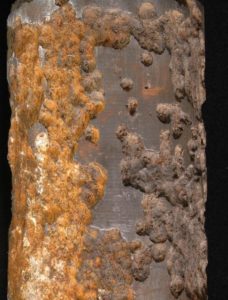CORROSION analysis and prevention
Corrosion of various types is a constant threat to oilfield equipment, costing up to 1.4 $B annually by some estimates. Equipment used in drilling and production is subject to attack by a number of aggressive species including hydrogen sulfide (H2S), carbon dioxide (CO2) and chlorides. High strength components are susceptible to various forms of environmental cracking including stress corrosion cracking (SCC) and sulfide stress cracking.
Some of the common corrosion mechanisms encountered in production environments include:
- SWEET — Sweet corrosion is caused by CO2 and water, which combine to form carbonic acid. Sweet corrosion manifests in various forms including general corrosion, pitting, and “mesa” attack.
- SOUR — Sour corrosion is caused by H2S, an acid gas encountered in many wells. H2S can cause embrittlement and sulfide stress cracking, often resulting in catastrophic failure.
- CHLORIDES — Chlorides promote localized corrosion and stress corrosion cracking.
- GALVANIC — Galvanic corrosion can occur when dissimilar metals are placed into contact.
- MICROBIOLOGICAL — Microbiologically Influenced Corrosion (MIC) is caused by bacteria that colonize the metal surface and produce acids and H2S as waste products.
- HTHP – High pressure/high temperature wells have bottom hole temperatures exeeding 300°F (150°C) and pressures up to 10000 psi. These extreme conditions push the limits of existing alloys and polymers and require careful material selection.
Corrosion testing is an effective means of predicting if a material is suitable for a given environment. We can arrange for testing at a number of qualified labs. Customized testing is available to fit your needs.
Our consulting metallurgists are available to assist with all of your corrosion-related issues, including suggesting preventative measures. Click below to contact us today.
